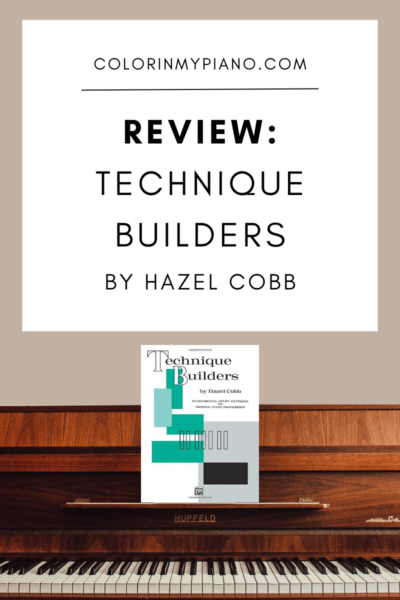
When it comes to piano technique, many pianists often think of exercises involving scales, arpeggios, chords, and more. However, at its core, technique is actually about sound – that is, being able to achieve a desired expressive effect on the instrument.
In piano teaching, technique exercises can provide young pianists with opportunities to explore different sounds and ways of using their bodies in an effective, efficient, healthy and comfortable manner. Unfortunately, pianist injuries are quite common, but by prioritizing student wellness, we can help turn this trend around.
Today, I want to share about a book I have been finding useful with my piano students over the past couple of years and now consider a go-to resource in my teaching. It’s called Technique Builders: Fundamental Study Patterns to Improve Piano Proficiency, by Hazel Cobb. In this review, you’ll learn why I recommend Technique Builders and how you can use it effectively in your piano teaching. (Bonus: Download my handy-dandy errata sheet at the end of this article!)
Note: This post contains affiliate links, which means my blog earns a small percentage should you decide to make a purchase using those links. Thanks for supporting my work!
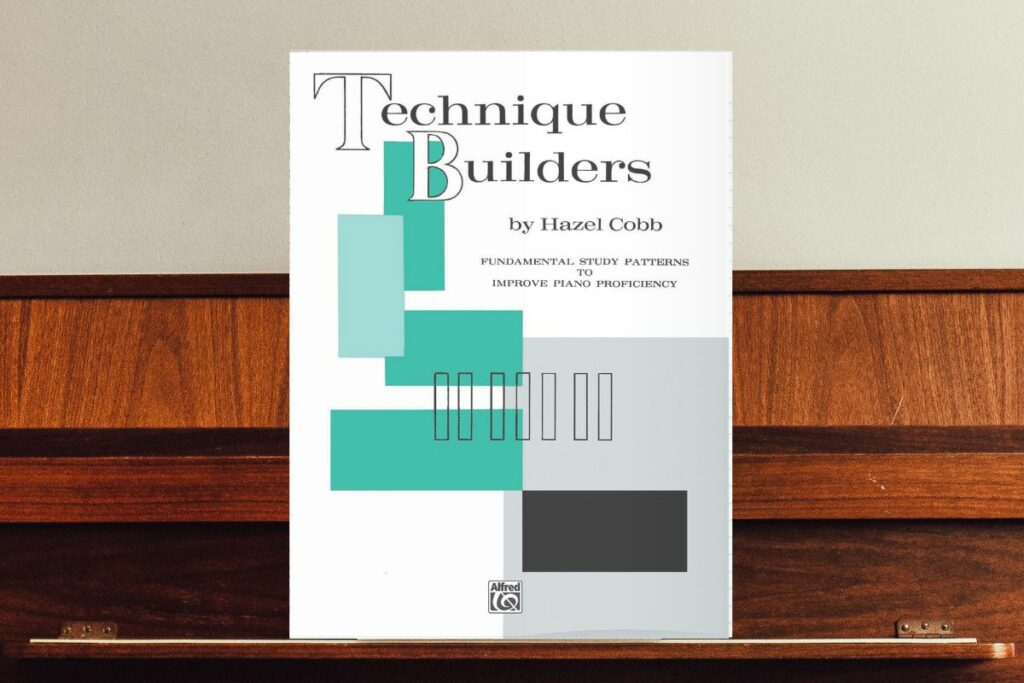
An Introduction to Hazel Cobb’s Technique Builders
Hazel Cobb’s Technique Builders: Fundamental Study Patterns to Improve Piano Proficiency is a book of short exercises for pianists that was first published in 1985 and is still available today through Alfred Publishing. In the forward, Cobb states her book is intended for any student who would benefit from special focus on technique, whether they are a beginner or more experienced performer. Further, she explains: “The ultimate objective is to train the student through repeated patterns and precise exercises, to acquire a conscious control in these techniques: the use of the whole arm for lateral freedom and arm weight, the forearm for rotation (Alberti bass and similar patterns), the wrist for flexibility in phrasing and the fingers for dexterity in passage work.”
I first heard about Cobb’s Technique Builders while attending a workshop in 2015 with Irina Gorin — master teacher and author of the Tales of a Musical Journey method. She recommended Technique Builders as a resource she finds worthwhile for her students, with the caveat that she likes to skip certain exercises.
I heard the book recommended again during a session I attended during the MTNA Virtual Conference in 2020. The session was given by Nancy O’Neill Breth, a respected veteran teacher and author of The Piano Student’s Guide to Effective Practicing guide and the accompanying Practicing the Piano book. She described having her students track their metronome tempos as they practice getting them up-to-speed (according to tempo goals she has noted for each exercise in her copy of the book.) She also mentioned teaching the exercises mostly by rote.
After being introduced to Technique Builders from these two master teachers, I knew I needed to check it out!
What Makes Technique Builders Unique
Technique Builders addresses a variety of skills throughout the book, as you can see from the Table of Contents page.
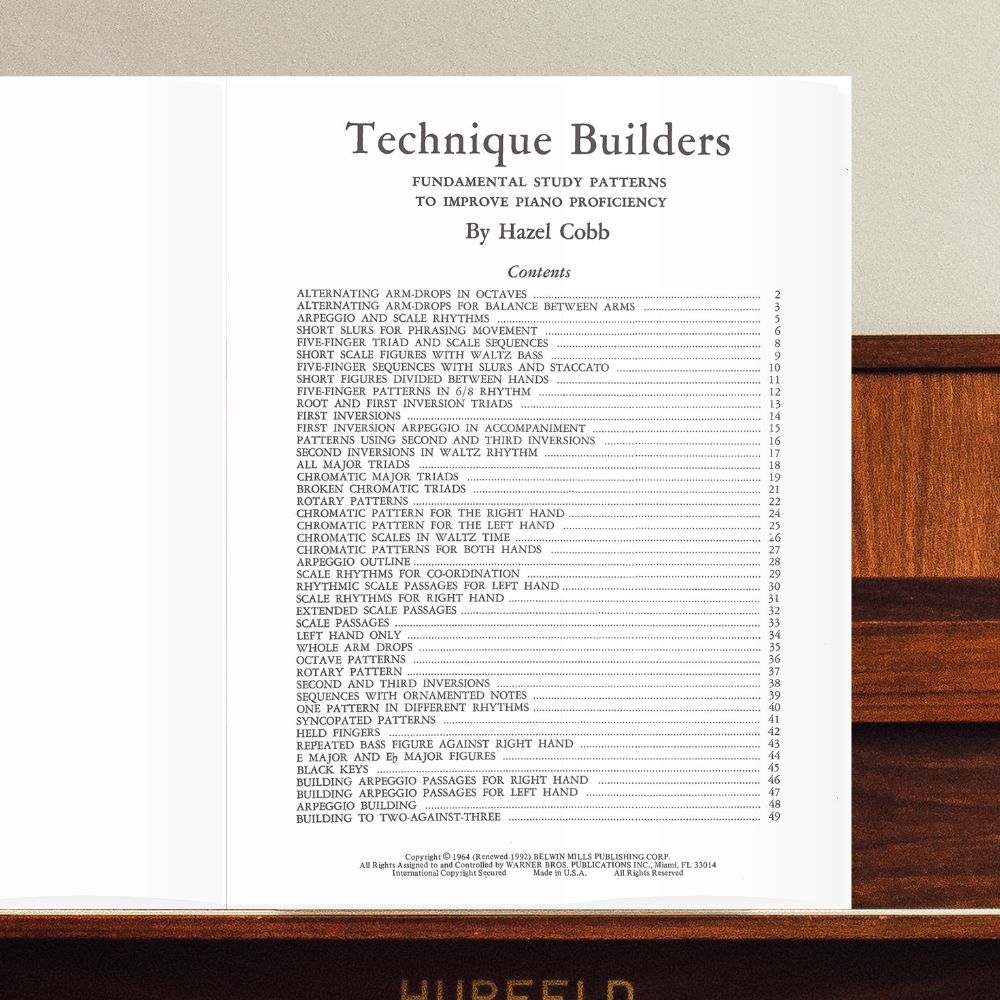
At the top of each page, there is a title (and sometimes also a subtitle) describing the exercises and/or the technical skill to be explored.

Most of the exercises in Technique Builders consist of sequenced patterns — meaning, they feature a one- or two-measure pattern that moves stepwise upwards or downwards across the keyboard. Typically, only the first few measures of each exercise are notated. The pianist is expected to continue the sequence in a similar manner until the next octave is reached.
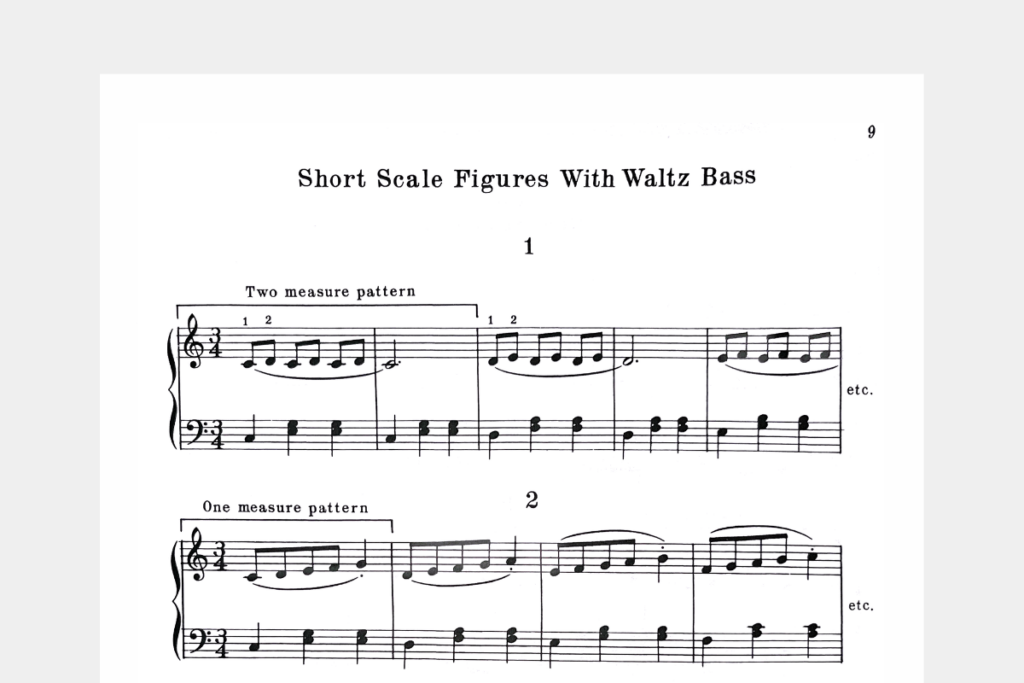
Because the exercises are generally not written out in their entirety, the pianist must analyze, understand, and mentally engage with the pattern in order to successfully perform it. This process builds the pianist’s aural and memory skills at the same time as their technique and artistry skills. It’s an interesting challenge, and the exercises sound appealing, too.
Many figures commonly encountered in classical music — including scale passages, arpeggios, waltz bass, and Alberti bass — are featured throughout the book. In addition, the pianist will encounter a variety and articulations (slurs, staccato) which should be carefully observed. Building familiarity with these elements will no doubt bleed over into the student’s classical repertoire and beyond.
How to Use Technique Builders in Your Piano Teaching
To trial Technique Builders, I suggest initially ordering copies for only a couple of intermediate students and observe the results after a few months before ordering more books for other students. I started small and now, after a couple of years of incorporating Technique Builders into my teaching, I’ve put about a dozen students through the book.
The exercises from Technique Builders can be used as a warm-up activity at the beginning of the lesson and can be demonstrated by the teacher before asking students to try them. It’s also important to discuss challenges and technique concepts with the exercises to bring them into the awareness of the student. Specifically, it is beneficial to explore ways to avoid excess tension — particularly in the hands and wrists — and to find comfortable movements that will facilitate execution of each exercises.

At the following lesson, you and your student can evaluate the assigned page to decide if the exercises can be considered mastered or if it needs another week or two of practice. Listen for the exercise to be accurate (in terms of pitches, rhythms, and markings such as slurs and staccatos), fluid (without stops and starts), artistic (aurally pleasing and expressive), physically comfortable, and at an acceptable tempo.
There are 49 pages in the book, which means there is material enough to last a year or two. Most students can handle an assignment of one page at a time, but some may happier focusing on only a half-page at a time.
Why I Recommend Technique Builders
Simply put, I recommend Technique Builders because my students and I love it. The exercises are interesting and fun to play. When students reach the end of the book, they want more!
As a teacher, I appreciate the focus on building familiarity with figurations and technique skills found in the repertoire they are learning. And I really like that the exercises are NOT fully notated, so that students must use comprehension skills, musical memory, and active thinking to successfully play the exercises (rather than mindlessly read them). Interestingly enough, however, for a couple of my students I’ve noticed that the rapid turnover of exercises has also helped improve their sight-reading.
Overall, Technique Builders is a valuable resource for piano teachers and students looking to improve piano proficiency. The sequence-based exercises and the variety of technical skills addressed make it unique and effective in building technique and artistry skills. I’m finding a plethora of benefits using Technique Builders, and I’m not aware of another resource quite like it!
An Important Caveat
The only caveat I have to recommending Technique Builders is the fact that there are quite a number of editing mistakes. There are so many, in fact, that I compiled them and created an errata sheet I can give to students along with the book. I am providing the printable to you as a freebie below, in case you’d also like to use it with your students.
The nature of the errors vary. Some are inaccurate pitches and fingerings. There are also two pages with titles that say “Second and Third Inversions” rather than “First and Second Inversions.” You can view the full list of errors I’ve discovered by downloading the PDF. Although it is inconvenient to have to correct these errors in the book, it is not enough to deter me from using this book with my students.
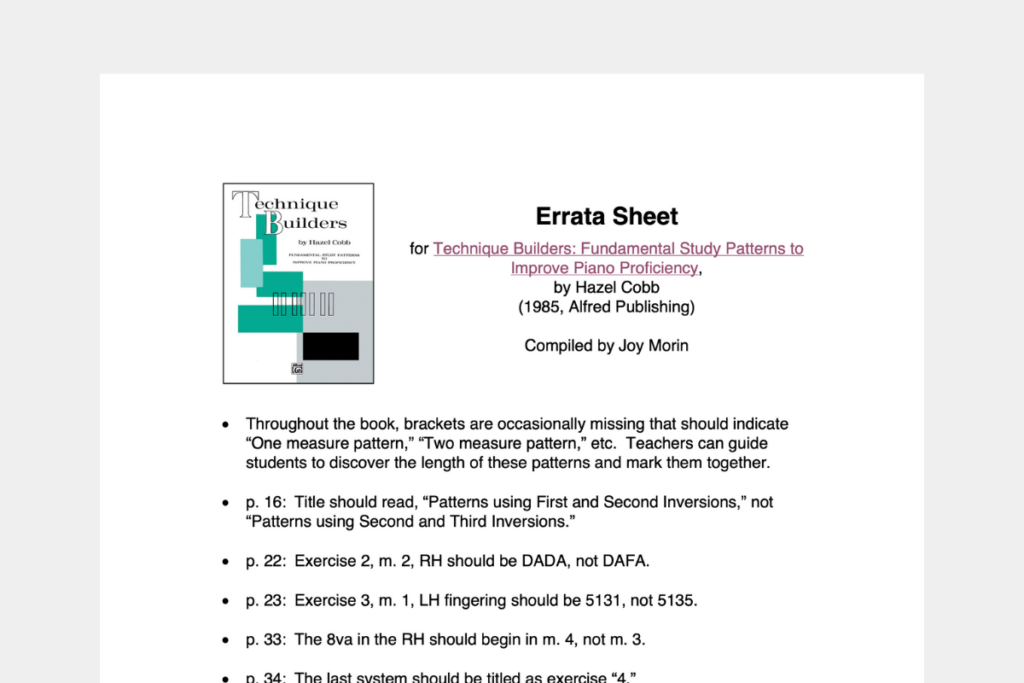
Download on the Errata Sheet on Printables > Other Resources page.
 Errata Sheet for Hazel Cobb's Technique Builders - by Joy Morin (347.1 KiB, 766 hits)
Errata Sheet for Hazel Cobb's Technique Builders - by Joy Morin (347.1 KiB, 766 hits)
Where to get Technique Builders
Hazel Cobb’s Technique Builders book can likely be purchased/ordered through your local music stop (if you are lucky enough to have one nearby to support!) and online from Amazon or SheetMusicPlus.com.
Your turn: What technique exercises or etudes do you use in your teaching? I’d love to hear!


Have you ever used Pathways to Artistry by Catherine Rollin? There are 3 levels of technique books and there are optional companion books (Masterworks and Repertoire) that tell you where to apply the techniques in “Real world settings”. I live out for many reasons you love this one; things are not fully notated, from book 1, students start transposing exercises in all major keys starting on white notes. It gets then comfortable playing in all keys (B starts out as the outcast and by the end is no big deal). The only downside is that they aren’t particularly interesting to play, but I have yet to have a student really complain. They like that we can break a page down to smaller elements and go at their own pace. I will definitely check this book out as something to piggy back on after Pathways Book 3!
Hi Melinda! I’ve looked at that series, but haven’t really used them with students before! My impression is that they are very five-finger based, otherwise I think I would use them more. I’m glad to hear your endorsement, though. Maybe I should give them a try sometime with a student.
I love junior Hannon. Usually just the first two patterns; one octave. A lot of students I teach by rote and they love it! It sounds so good. I want to look into your technique builders!
Yes, Junior Hanon is another classic technique resource for students!
Thank you for reviewing this book. I start my beginners on Piano Safari Animal Adventures half way through the year. We only do the non legs to techniques. The second year we focus on the legs to techniques in the second half of the book. I was looking for a technique book to use in the years after that. I was brought up on FingerPower. However, I am looking for something that focuses on the sound a movement produces not the fingering and pattern. It looks like this book is what I am looking for.
Glad to hear it, Beth! Thanks for sharing!
In using Frances Clark’s “Music Tree” series, I noticed several pieces included which were composed by Hazel Cobb. Francis Clark had a group of composers under contract and they were fine, but as I worked with the books I found that certain pieces always stood out above the others in appeal and musicality. It turned out these were all composed by Hazel Cobb. Later I came upon a book of her pieces in an estate sale, and grabbed it. Her style was consistent. Unfortunately, I have not found her music in music stores. I would like to see a revival of them.
I agree — I wish more of Hazel Cobb’s music was still available!
It 100% makes sense that this would improve students’ sight reading, as the way it’s presented, in patterns, chunks information for the student. So when they read the pattern later, it’s like they’re reading one thing instead of several different notes.
Thanks for sharing! I may steal her idea and make something similar for my students…
Great article and discussion! I rarely do any technique- yikes- time to get started. Looks like fun.
It really is a fun book! I am pleased with how much my students enjoy it. 🙂
Thanks for sharing this with us, it looks like a great book! Do you play all the exercises as written, or do you have them transpose them into different keys? (thinking of the Waltz bass page you showed above)
It depends on the student! I’ve had certain students do some transposing, if I think they can handle it and would benefit from it! I definitely think it’s a good idea.